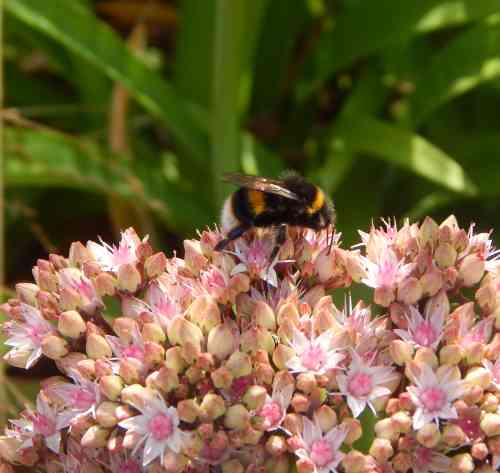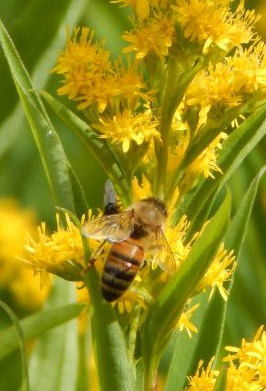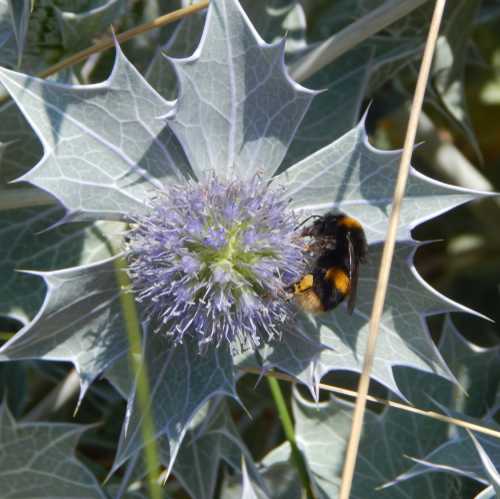Drought Plants For
Bees and Pollinators
Initially, many people who find themselves with a dry or drought garden, may believe their options will be limited and their gardens will be dull.
However, there are many excellent drought plants out there, that are highly attractive to pollinators.
What is more, drought or dry landscapes and gardens do not have to be boring – they can even be truly inspiring and striking. If nature has created certain conditions, then you'll find there are species that will thrive in those conditions. "Nature abhors a vacuum" as they say!
By combining different textures, forms and colours, the effect created can be visually stunning. Herbs, wildflowers and succulents especially, provide great options for gardeners wanting to attract bees to dry areas.
Bee-friendly Drought Tolerant Plants
In general, if you have a dry garden, try to find plants that naturally thrive in drought conditions. I have found it's far better to work with nature than against her, and much easier to select plants that thrive happily in such situations, rather than trying to water your plants every day!
Succulents
 Above: Bumble bee foraging on Sempervivum
Above: Bumble bee foraging on SempervivumSucculents, such as Sedums and Sempervivums are great drought
resistant plants with some lovely varieties available that attract bees and other pollinators.
They are able to store water in their fleshy leaves and stems during wetter spells, and draw on that moisture when needed. Their compact flower heads ooze nectar during the late summer, and are loved by bees and other pollinating insects.
 Above: Bumble bee foraging on sedum. Some sedums can provide useful early autumn food for bees when other flowers are fading. A variety of bee species enjoy foraging on the flowers.
Above: Bumble bee foraging on sedum. Some sedums can provide useful early autumn food for bees when other flowers are fading. A variety of bee species enjoy foraging on the flowers.
Herbs
Many herbs can tolerate dry conditions. Try:
- Lavender – lavender thrives in gritty, dry soils, and will buzz with bees in the summer.
- Thyme – low-growing thyme can also be grown on a green roof – although it may then be difficult for you to harvest some of it!
- Origanum, (Marjoram) – the culinary oregano can be enjoyed by both you and the bees!
- Sage – both culinary and wild sages are not only good drought plants, they are also good bee plants too.
- Rosemary – will provide valuable food for bees early in the year when other foraging opportunities are scarce.
I have a further page about herbs for bees here.
Wildflowers
 Honey bee on Solidago - golden rod. A large patch grows wild in sandy soil on sand dunes, close to where I live. Every year, it is visited by many pollinators.
Honey bee on Solidago - golden rod. A large patch grows wild in sandy soil on sand dunes, close to where I live. Every year, it is visited by many pollinators.Many wildflowers are well adapted to tolerate dry conditions, and thrive on low-nutrient soils.
Cultivated varieties are often available, from poppies and Solidago to Eryngium and toad flax.
Excellent drought plants that attract bees and other pollinators include:
Poppies
Cornflower
Candy tuft
Toadflax
Thistles
Bugle (Ajuga)
Rosa rugosa
Deadnettle
Selfheal
Teasels
Other drought tolerant plants to attract bees
 Bees love sea holly, and it's great for dry, sandy gardening conditions, such as coastal areas.
Bees love sea holly, and it's great for dry, sandy gardening conditions, such as coastal areas.Beach aster
Achillea millefolium
Phacelia - Scorpion weed
Ceanothus repens
Eryngium - Sea Holly
Helianthemum - the rock rose
Verbascum
Drought resistant ground cover and lawns
 Bumble bee foraging on white clover
Bumble bee foraging on white cloverOne of the
easiest ways to deal with a lawn in drought conditions, is to allow
clover to flourish. It will help to keep your lawn looking green, and bees love
it! Red clover is especially favoured, but I find white clover springs up naturally on mine.
Later, after mowing, the clover makes an excellent nutritious
compost for other plants.
Alternatively, again, why not cover your lawn area with low growing thyme plants?
More articles about bees and plants
- Bees And Brambles: The Value Of Brambles To Bees Also known as blackberry bush, research shows each bramble flower secretes lots of nectar for bees!
- Bees And Bee Balm Bee Balm (Monarda) - also known as 'Bergamot) is a herbaceous perennial which is attractive for bees.
- 30 Fantastic Garden Flowers For Bees Flowering plant recommendations for the perfect bee garden.
- Bees love lupins – but so do slugs and snails, so what can you do? Here's a way to protect your lupins....using garlic!
- Plant Oregano For Bees (Marjoram) It's rich in nectar, and attracts bees, butterflies and hoverflies in summer. Here's how to plant it.
- Fennel Pollen And Nectar Bees love fennel! How to grow it, gather it, and the many uses of fennel seeds and pollen.